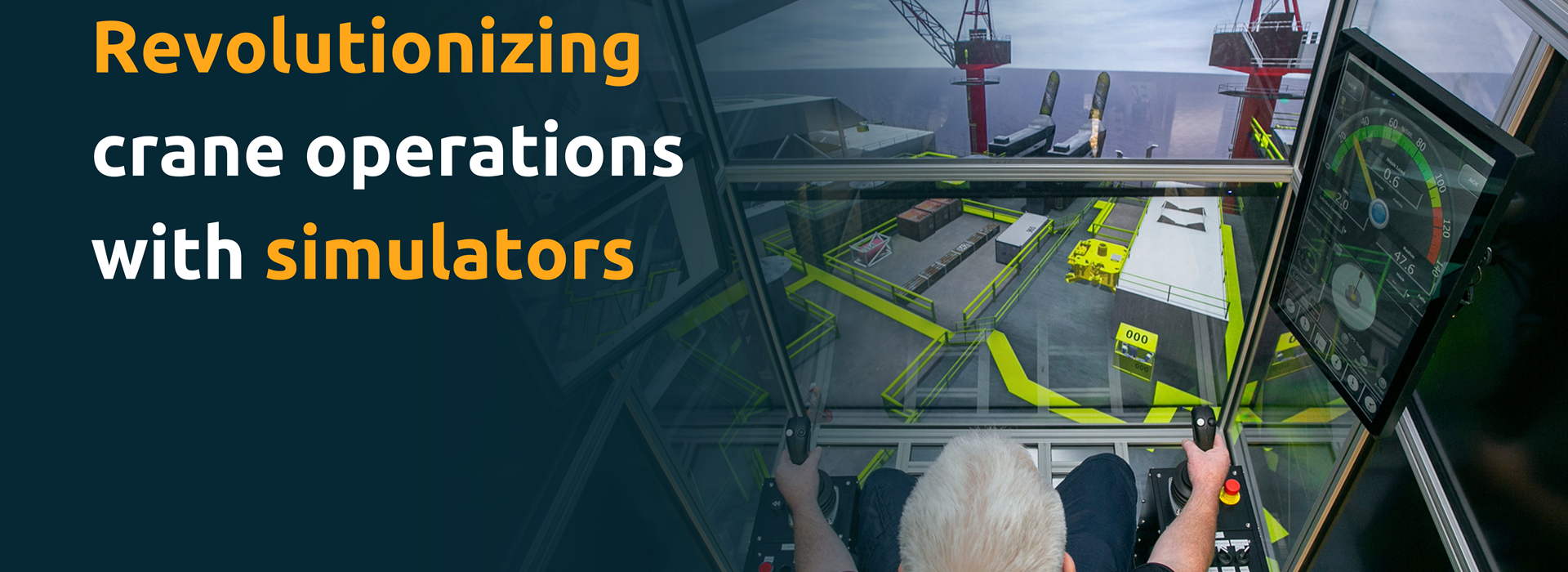Ok
Introduction
In many industries across the world lifting heavy loads is a central task in daily operations. Here, cranes are a vital machine in everyday work life. Also, in the wind industry cranes and lifting operations are central to keeping the sector running smoothly. At the same time, cranes and lifting operations account for a vast number of accidents across different industries and countries. Often, incidents happen due to a lack of training and safety awareness, resulting in a dangerous working environment for crane operators and other workers, and increased costs for the companies deploying them. Luckily, modern simulators can help train workers in a safe but incredibly realistic manner and help educate a workforce that knows how to react in critical situations.
Why use lifting simulators?
Cranes can be complicated to operate. The most commonly used cranes - typically either mobile or tower cranes - lift the object outside their supporting base, resulting in the lifting process turning into a difficult balancing act. Here, the crane tipping over is considered the most common accident. On the other hand, when operating cranes that lift inside their supporting bases, and are thus incapable of tipping, rigging accidents are most common to happen. Naturally, these dangerous scenarios cannot be trained in the real world, making the use of simulators an optimal way to prepare workers for critical situations.
Using a simulator, provides a safe training environment for crane operators to fast-track their lifting skills, gain realistic lifting experience and competence. Experience shows that simulation-aided training is an unrivaled, efficient way to fast-track crane operators’ capabilities and confidence. Followingly, using simulators can bring significant advantages when educating crane operators:
- Heightened safety awareness: As the simulator exposes the worker to many different and tricky scenarios, the operator is able to gain real life experience with safety critical situations like poorly secured loads. Thanks to this, simulation-aided training can help reduce accidents significantly.
- Assess complex operations beforehand: Being able to precisely simulate our clients’ scenarios with our technology, challenges that could arise during the lift can be revealed beforehand. The crane operator is, therefore, able to identify difficulties already when using the simulator - which can thus be avoided during the real-life operation.
- Increase workers’ efficiency: Simulators allow us to pinpoint where crane operators can optimize their workflow so they are able to maximize the amount of lifts they perform per hour. With the help of simulation-aided training, lifting efficiency can thus be improved.
- Decrease costly downtime: One solution to avoiding expensive breakdown is to make sure crane operators have undergone the correct training and have the necessary skills and knowledge to navigate different scenarios in connection with their lifting tasks.
- Pre-assess new staff: To evaluate the skill levels of new applicants, a simulator provides the perfect tool when hiring new workers. The simulator can act as an assessment tool where candidates show the proficient skills needed for a particular job - like crane operators, slinger and banksman.
All in all, the use of simulators in training helps build a more robust performance and safety culture, to help keep workers and the environment safe. Also from a financial perspective simulation-aided training offers many advantages, e.g. the possibility to practice complex lifts beforehand, significantly reducing errors during the actual lift. Additionally, the possibility to optimize workflows and eliminate bad habits by using simulators can help reduce costs and increase safety.
Offshore Lifting Operations
Among lifting operations, offshore lifts represent a special category. The sea and weather conditions alone lead to significantly different lifting scenarios when operating offshore - resulting in a much more comprehensive range of challenges. In summary, we identified two main challenges when lifting. Firstly, offshore lifts are often dynamic, meaning that either the crane and/or the load’s destination are on a moving surface – e.g. lifting from one ship to another. Secondly, offshore lifts are carried out in highly weather-exposed work sites, where cargo, platform, and cranes are exposed to current, wind waves and more.
Nevertheless, offshore lifts are quite common in multiple industries, like for example when building offshore wind parks. It is, therefore, highly important that these workers get the adequate education and training - to ensure a safe work environment. Additionally, damage caused by dropped loads on offshore sites can be significantly more costly to repair and should thus be avoided in order to save financial resources and keep the operations running. In order to execute an offshore lift correctly, the crane operator needs to have sufficient experience and know-how. To achieve this, simulation-aided training is a perfect sandbox for crane operators to practice and boost their skills.
Why RelyOn Nutec?
At RelyOn Nutec, we develop and deliver world-leading simulator solutions within our network of global training centers, to help our clients improve safety while increasing operational efficiency and reducing costs. With our state-of-the-art simulator systems we are able to bring training to life, allowing companies to practice complex operations in a safe and controlled training environment, bringing real-life operational scenarios into your training program. Our dynamic simulator technology provides a high-fidelity learning experience with unmatched realism to ensure optimal training outcomes.
As we can program our simulators to create a digital replica of the client’s lifting operation, it allows workers to practice the scenario beforehand. Thanks to this, work processes can be optimized and time can be saved during the real life operation since possible challenges can already be identified before the actual lift takes place. Our in-house technology allows us to customize the learning experience to individuals or crews. By having integrated our simulators, instructors, and training course library under one roof, we can deliver our clients effective and high-quality training programs and help them improve operational efficiency and safety.
Conclusion
Modern computer-based simulators and incredibly realistic operating scenarios can significantly help train crane operators to become much more capable when operating cranes. Like this, we help our clients improve safety and efficiency - to optimize their lifting operations. If you would like to have more insights into our lifting simulation, you can download our whitepaper here.
Next read
-

-

-
 Article 14. June 2024
Article 14. June 2024 -

Ensuring Safety and Efficiency: IRATA Rope Access Training for a Safer Work Environment
In industries such as oil & gas and renewables, where accessing challenging locations is common, rope access methods provide a safe and efficient solution. These methods offer technicians a secure means of navigating heights and restricted areas while minimizing environmental impact. However, proficiency in rope access requires proper training and a globally accepted safety education.
Article 4. June 2024 -

Polaris Sells RelyOn Nutec to Mubadala Capital
The acquisition, part of Mubadala Capital’s flagship Private Equity Fund IV, strengthens the asset manager’s footprint in the business services sector.
Article 24. May 2024 -

RelyOn Nutec Acquires Electrical Training and Consultancy Specialist Quercus Technical Services, Fast-tracking European Electrical Capability Build
Effective May 21st, RelyOn Nutec has acquired Quercus Technical Services BV, one of the largest specialist electrical safety and skills training organizations in the Netherlands. The acquisition of Quercus bolsters RelyOn Nutec’s position in the electrical training market and accelerates its European roll out.
Article 22. May 2024 -

-
 Article 2. May 2024
Article 2. May 2024
